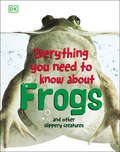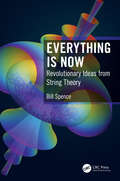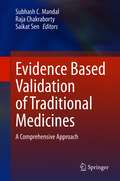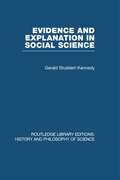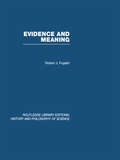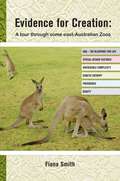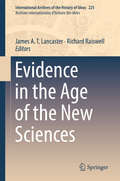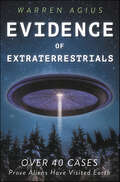- Table View
- List View
Everything Is Tuberculosis: The History and Persistence of Our Deadliest Infection
by John GreenJohn Green, the #1 bestselling author of The Anthropocene Reviewed and a passionate advocate for global healthcare reform, tells a deeply human story illuminating the fight against the world’s deadliest infectious disease. <p> “This highly readable call to action could not be more timely.” –Kirkus, starred review. <p> “Memorably probes the intersections of medicine and human emotion.” –Bookpage, starred review. <p> Tuberculosis has been entwined with humanity for millennia. Once romanticized as a malady of poets, today tuberculosis is seen as a disease of poverty that walks the trails of injustice and inequity we blazed for it. In 2019, author John Green met Henry Reider, a young tuberculosis patient at Lakka Government Hospital in Sierra Leone. John became fast friends with Henry, a boy with spindly legs and a big, goofy smile. In the years since that first visit to Lakka, Green has become a vocal advocate for increased access to treatment and wider awareness of the healthcare inequities that allow this curable, preventable infectious disease to also be the deadliest, killing over a million people every year. <p> In Everything Is Tuberculosis, John tells Henry’s story, woven through with the scientific and social histories of how tuberculosis has shaped our world—and how our choices will shape the future of tuberculosis. <b>New York Times Bestseller</b>
Everything You Need To Ace Biology In One Big Fat Notebook (Big Fat Notebook)
by Matthew Brown Workman PublishingThis Big Fat Notebook covers everything you need to know during a year of high school BIOLOGY class, breaking down one big bad subject into accessible units. Including: biological classification, cell theory, photosynthesis, bacteria, viruses, mold, fungi, the human body, plant and animal reproduction, DNA & RNA, evolution, genetic engineering, the ecosystem and more. Study better with mnemonic devices, definitions, diagrams, educational doodles, and quizzes to recap it all.
Everything You Need to Ace Biology in One Big Fat Notebook (Big Fat Notebooks)
by Matthew Brown Workman PublishingThe Big Fat Notebooks go to high school! This study guide for high school Biology introduces students to all the big ideas in the course, with clear diagrams, fun doodles, clever mnemonics, and other ways to understand and remember what you need to ace this challenging course.
Everything You Need to Ace Science in One Big Fat Notebook: The Complete Middle School Study Guide
by Workman PublishingIt’s the revolutionary science study guide just for middle school students from the brains behind Brain Quest. Everything You Need to Ace Science takes readers from scientific investigation and the engineering design process to the Periodic Table; forces and motion; forms of energy; outer space and the solar system; to earth sciences, biology, body systems, ecology, and more.
Everything You Need to Know About Acne (Need to Know Library)
by Jennifer CeaserDescribes the different types of acne, their causes, treatment, and prevention.
Everything You Need to Know About Dinosaurs: And Other Prehistoric Creatures (Everything You Need to Know)
by DKA fun, fact-filled dive into the world of dinosaurs for kids-packed full of brilliant images.All the basics of these amazing creatures are covered in this beautiful and informative book on dinosaurs. Anatomy, along with habitat and behavior, and lots of fascinating facts about dinosaurs that every child will just love reading about. See how they survived all over the world, and how these prehistoric creatures adapted to their ancient habitats. Alongside, in between, and on top of all that, Everything You Need to Know About Dinosaurs also provides ideas for things to make, games to play, quizzes, and amazing facts to share with friends. Every spread is self-contained to make this a dip-into book with a difference. From the very first page it combines little-known information with engaging text and innovative, high-quality design.It's everything you need to know, and everything you want to find out.
Everything You Need to Know About Frogs and Other Slippery Creatures (Everything You Need to Know)
by DKDiscover the amazing world of our cold-blooded friends in this book all about frogs and amphibians for kids.Embark on a fun, fact-filled dive into the world of frogs and amphibians with Everything You Need to Know About Frogs. Children will love to learn all the basics of reptile and amphibian anatomy in this beautiful and informative book on frogs.Packed with vibrant pictures and lots of fascinating facts, kids can enjoy learning all about a frog&’s habitat and behavior. Discover how these amphibians survive in lakes and rivers, forests and deserts, and how these clever creatures have adapted to live in seemingly inhospitable habitats. Alongside, in between, and on top of all that, this riveting frog book also provides ideas for things to make, games to play, quizzes, and amazing facts to share with friends!Inside the pages of this frog book for children, you&’ll find: A whole host of amphibians and reptiles including toads, snakes, lizards, salamanders, turtles, newts, tortoises and crocodiles.Close-ups, quizzes, and games with an exciting take on the amazing world of our cold-blooded friends.A look at these creatures from all angles – information on habitat and breeding habits, as well as oddities such as how to survive a crocodile&’s attack, how a frog&’s legs influenced Frankenstein, or how to play snakes and ladders.Children aged 7+ can learn all about frogs and amphibians from the very first page of this book, which combines little-known information with engaging text and an exciting design. Each page contains everything kids need to know, and everything they WANT to find out about frogs!. Complete the seriesThis delightful frog book is part of the Everything You Need to Know series of educational books for children and also includes Everything You Need to Know About Snakes and Everything You Need to Know About Dinosaurs!
Everything You Need to Know About Snakes (Everything You Need to Know)
by John Woodward DKDiscover the amazing world of reptiles in this book all about snakes for kids.Embark on a fun, fact-filled dive into the world of snakes with Everything You Need to Know About Snakes. Children will love to learn all the basics of reptile anatomy in this beautiful and informative book on our serpent friends.Packed with vibrant pictures and lots of fascinating facts, kids can enjoy learning all about a snake&’s habitat and behavior. See how they survive in forests, deserts, and oceans, and how these clever creatures have adapted to live in seemingly inhospitable habitats. Alongside, in between, and on top of all that, this riveting snake book also provides ideas for things to make, games to play, quizzes, and amazing facts to share with friends!Inside the pages of this reptile book for children, you&’ll find:- Facts on habitat and anatomy, as well as oddities such as why snakes have scales and why chameleons change color.-Close-ups, quizzes, and games with an exciting take on the amazing world of our cold-blooded friends.-A look at these creatures from all angles – information on habitat and breeding habits, as well as information on pythons, Komodo dragons, sea turtles, and many more.Children aged 7+ can learn all about snakes from the very first page of this book, which combines little-known information with engaging text and an exciting design. Each page contains everything kids need to know, and everything they WANT to find out about snakes!Complete the seriesThis delightful snake book is part of the Everything You Need to Know series of educational books for children and also includes Everything You Need to Know About Frogs and Everything You Need to Know About Dinosaurs!
Everything You Need to Know about Dinosaurs (Everything You Need to Know)
by John Woodward DKDiscover the amazing world of prehistoric reptiles in this book all about dinosaurs for kids.Embark on a fun, fact-filled dive into the prehistoric world with Everything You Need to Know About Dinosaurs. Children will love going back in time and learning about these cold-blooded creatures.Packed with vibrant pictures and lots of fascinating facts, kids can enjoy learning about how dinosaurs survived all over the world and how they adapted to their ancient habitats. Discover the anatomy, habitat and behavior of these prehistoric creatures through fascinating facts that children aged 7+ will love reading about. Alongside, in between, and on top of all that, this riveting dinosaur book also provides ideas for things to make, games to play, quizzes, and amazing facts to share with friends!This dinosaur book for children offers:- An introduction to a whole host of dinosaurs including Stegosaurus, Velociraptor, Pterodactylus and the mighty Tyrannosaurus rex.- Close-ups, quizzes, and games with an exciting take on the amazing world of our cold-blooded friends.- A look at these creatures from all angles – information on habitat and breeding habits, as well as oddities such as which dinosaurs would win in a race, why some dinosaurs were &“boneheads&”, and how scientists uncover the colors of dinosaur feathers. Children aged 7+ can learn all about prehistoric creatures from the very first page of this book, which combines little-known information with engaging text and an exciting design. Each page contains everything kids need to know, and everything they WANT to find out about dinosaurs!Complete the SeriesThis delightful dinosaur book is part of the Everything You Need to Know series of educational books for children and also includes Everything You Need to Know About Snakes and Everything You Need to Know About Frogs!
Everything and More: A Compact History of Infinity
by David Foster WallaceDavid Wallace brings his intellectual ambition to the story of how mathematicians have understood the infinite, from the ancient Greeks to the nineteenth-century mathematical genius Cantor's discovery that there is more than one kind of infinity.
Everything in Its Place: First Loves and Last Tales
by Oliver SacksFrom the bestselling author of Gratitude and On the Move, a final volume of essays that showcases Sacks's broad range of interests--from his passions for ferns, swimming, and horsetails, to his final case histories exploring schizophrenia, dementia, and Alzheimer's.Oliver Sacks, renowned scientist and storyteller, is adored by readers for his neurological case histories, his fascination and familiarity with human behaviour at its most unexpected and unfamiliar. Everything in Its Place is a celebration of Sacks's myriad interests, all told with his characteristic compassion, erudition, and luminous prose. From the celebrated case history of Spalding Gray that appeared in The New Yorker four months before his death to reflections on mental asylums; from piercing accounts of Schizophrenia to a reminiscence of Robin Williams; from the riveting tale of a medical colleague falling victim to Alzheimer's to the cinematography of Michael Powell, this volume celebrates and reflects the wondrous curiosity of Oliver Sacks.
Everything in Its Place: First Loves and Last Tales
by Oliver SacksFrom the legendary author of The Man Who Mistook His Wife for a Hat: a volume of essays on everything from primordial life and the mysteries of the brain to the ancient ginkgo and the power of the written word. "Magical . . . [Everything in Its Place] showcases the neurologist's infinitely curious mind."—People MagazineIn this volume, Oliver Sacks examines the many passions that defined his life--both as a doctor engaged with the central questions of human existence and as a polymath conversant in all the sciences. Everything in Its Place brings together writings on a rich variety of topics. Why do humans need gardens? How, and when, does a physician tell his patient she has Alzheimer's? What is social media doing to our brains? In several of the compassionate case histories included here, we see Sacks consider the enigmas of depression, psychosis, and schizophrenia for the first time. In others, he returns to conditions that have long fascinated him: Tourette's syndrome, aging, dementia, and hallucinations. In counterpoint to these elegant investigations of what makes us human, this volume also includes pieces that celebrate Sacks's love of the natural world--and his final meditations on life in the twenty-first century.
Everything is Now: Revolutionary Ideas from String Theory
by Bill SpenceThis engaging and beautifully written book gives an authoritative but accessible account of some of the most exciting and unexpected recent developments in theoretical physics. – Professor Lionel J Mason, Mathematical Institute, University of Oxford String theory is often paraded as a theory of everything, but there are a large number of untold stories in which string theory gives us insight into other areas of physics. Here, Bill Spence does an excellent job of explaining the deep connections between string theory, particle physics, and the novel way of viewing space and time. – Professor David Tong, Department of Applied Mathematics and Theoretical Physics, University of Cambridge Foremost amongst Nature’s closest-guarded secrets is how to unite Einstein’s theory of gravity with quantum theory – thereby creating a ‘quantum space-time’. This problem has been unsolved now for more than a century, with the standard methods of physics making little headway. It is clear that much more radical ideas are needed, and our front-line researchers are showing that string theory provides these. This book describes these extraordinary developments, which are helping us to think in entirely new ways about how physical reality may be structured at its deepest level. Amongst these ideas are that Everything can happen at the same time – it is all Now; Hidden spaces, large and small, are everywhere amongst us; The basic objects are ‘membranes’ that behave like soap bubbles and can explore the shape of spacetime in new ways; We are holographic projections from higher dimensions; You can take the ‘square root’ of gravity; Ideas from the ancient Greeks are resurfacing in a beautiful new form; And the very latest work shows that ‘staying positive’ is essential. The book is aimed at a general audience, using analogies, diagrams, and simple examples throughout. It is intended as a brief tour, enabling the reader to become aware of the main ideas and recent work. A full list of further resources is supplied. Bill Spence is the founding Director of the Centre for Research in String Theory at Queen Mary University of London. He has worked on string theory for over three decades.
Evidence
by Lucy SanteFollowing Low Life, Lucy Sante's acclaimed evocation of the underside of New York City's history, Evidence is an investigation into the mysteries of crime, death, and photography that only this brilliant and original writer could conduct.In one sense Evidence is a picture book - a collection of 55 evidence photographs taken by the New York City Police Department between 1914 and 1918. These are startling images, some brutal, some poetic, and all possessed of a strange and spectral beauty.Lucy Sante minutely examines these pictures of crime scenes and draws them out by every possible means: speculating about the lives and deaths depicted; discussing the progress of the forensic use of photographs and the mission of photography itself; and, where possible, reconstructing the events that led up to these frozen terminal images. Evidence is many things at once: aesthetic object, historical and sociological document, mystery novel, memento mori, and time machine.
Evidence Based Validation of Traditional Medicines: A comprehensive Approach
by Saikat Sen Raja Chakraborty Subhash C. MandalThe demand for traditional medicines, herbal health products, herbal pharmaceuticals, nutraceuticals, food supplements and herbal cosmetics etc. is increasing globally due to the growing recognition of these products as mainly non-toxic, having lesser side effects, better compatibility with physiological flora, and availability at affordable prices. In the last century, medical science has made incredible advances all over the globe. In spite of global reorganization and a very sound history of traditional uses, the promotion of traditional medicine faces a number of challenges around the globe, primarily in developed nations. Regulation and safety is the high concern for the promotion of traditional medicine. Quality issues and quality control, pharmacogivilane, scientific investigation and validation, intellectual property rights, and biopiracy are some key issues that restrain the advancement of traditional medicine around the globe. This book contains diverse and unique chapters, explaining in detail various subsections like phytomolecule, drug discovery and modern techniques, standardization and validation of traditional medicine, and medicinal plants, safety and regulatory issue of traditional medicine, pharmaceutical excipients from nature, plants for future. The contents of the book will be useful for the academicians, researchers and people working in the area of traditional medicine.
Evidence Contestation: Dealing with Dissent in Knowledge Societies (Routledge Studies in the Philosophy of Science)
by Mariacarla Gadebusch Bondio Karin Zachmann Saana Jukola Olga SparschuhThis book examines the practices of contesting evidence in democratically constituted knowledge societies. It provides a multifaceted view of the processes and conditions of evidence criticism and how they determine the dynamics of de- and re-stabilization of evidence. Evidence is an essential resource for establishing claims of validity, resolving conflicts, and legitimizing decisions. In recent times, however, evidence is being contested with increasing frequency. Such contestations vary in form and severity—from questioning the interpretation of data or the methodological soundness of studies to accusations of evidence fabrication. The contributors to this volume explore which actors, for what reasons and to what effect, question evidence in fields such as the biological, environmental, and health sciences. In addition to actors inside academia, they examine the roles of various other actors, including citizen scientists, counter-experts, journalists, patients, consumers, and activists. The contributors tackle questions of how disagreements are framed and how they are used to promote vested interests. By drawing on methodological and theoretical approaches from a wide range of fields, this book provides a much-needed perspective on how evidence criticism influences the development and state of knowledge societies and their political condition. Evidence Contestation will appeal to scholars and advanced students working in philosophy of science, epistemology, bioethics, science and technology studies, the history of science and technology, and science communication.
Evidence Matters
by Susan HaackIs truth in the law just plain truth - or something sui generis? Is a trial a search for truth? Do adversarial procedures and exclusionary rules of evidence enable, or impede, the accurate determination of factual issues? Can degrees of proof be identified with mathematical probabilities? What role can statistical evidence properly play? How can courts best handle the scientific testimony on which cases sometimes turn? How are they to distinguish reliable scientific testimony from unreliable hokum? These interdisciplinary essays explore such questions about science, proof, and truth in the law. With her characteristic clarity and verve, Haack brings her original and distinctive work in theory of knowledge and philosophy of science to bear on real-life legal issues. She includes detailed analyses of a wide variety of cases and lucid summaries of relevant scientific work, of the many roles of the scientific peer-review system, and of relevant legal developments.
Evidence and Evolution
by Elliott SoberHow should the concept of evidence be understood? And how does the concept of evidence apply to the controversy about creationism as well as to work in evolutionary biology about natural selection and common ancestry? In this rich and wide-ranging book, Elliott Sober investigates general questions about probability and evidence and shows how the answers he develops to those questions apply to the specifics of evolutionary biology. Drawing on a set of fascinating examples, he analyzes whether claims about intelligent design are untestable; whether they are discredited by the fact that many adaptations are imperfect; how evidence bears on whether present species trace back to common ancestors; how hypotheses about natural selection can be tested, and many other issues. His book will interest all readers who want to understand philosophical questions about evidence and evolution, as they arise both in Darwin's work and in contemporary biological research.
Evidence and Explanation in Social Science: An Inter-disciplinary Approach (Routledge Library Editions: History & Philosophy of Science)
by Gerald Studdert-KennedyOriginally published in 1975. The main concern of this book is the nature of the gap between the theoretical issues, raised at an abstract level by social scientists, and their facts, the material organized in an empirical analysis. The author draws on material from several disciplines to explore the contributions of social science theory to historical insight.
Evidence and Meaning: Studies in Analytic Philosophy (Routledge Library Editions: History & Philosophy of Science)
by Robert J FogelinOriginally published in 1967. This is an examination of warrant statements – statements which indicated something about the grounds on behalf of some further judgement, choice or action. The first part of the study is concerned with the role of warrant statements in theoretical discourse; while the second part concerns their role in practical discourse. Also examined are necessity, probability, knowing, seeing and the complex of terms which allow us to introduce an argumentative structure into discourse.
Evidence for Creation
by Fiona SmithThis book focuses on specific design features of many Australian, and other, animals as well as other evidence for intentional creation by a Creator.It is intended as an aid when visiting east-Australian zoos, as well as a study manual for biology students, at a level of academic rigour expected in high school (or above) science.With its clear apologetic for creation, it is meant as a counter to the plethora of academic biology books and documentaries that extol evolution by random chance and time. In the book, the reader will be introduced to many standard biological terms used at the middle and upper high school level. These have all been well defined. There is also a Glossary at the back to help revise any new terms. The book is sectioned by animals (in alphabetical order) and apologetics. At the end of each section there are Review Questions to re-enforce learning for the student or enquiring adult. Answers to these appear at the back. The book also contains many colour photographs of the animals described.
Evidence in the Age of the New Sciences (International Archives of the History of Ideas Archives internationales d'histoire des idées #225)
by James A.T. Lancaster Richard RaiswellThe motto of the Royal Society—Nullius in verba—was intended to highlight the members’ rejection of received knowledge and the new place they afforded direct empirical evidence in their quest for genuine, useful knowledge about the world. But while many studies have raised questions about the construction, reception and authentication of knowledge, Evidence in the Age of the New Sciences is the first to examine the problem of evidence at this pivotal moment in European intellectual history. What constituted evidence—and for whom? Where might it be found? How should it be collected and organized? What is the relationship between evidence and proof? These are crucial questions, for what constitutes evidence determines how people interrogate the world and the kind of arguments they make about it.In this important new collection, Lancaster and Raiswell have assembled twelve studies that capture aspects of the debate over evidence in a variety of intellectual contexts. From law and theology to geography, medicine and experimental philosophy, the chapters highlight the great diversity of approaches to evidence-gathering that existed side by side in the sixteenth and seventeenth centuries. In this way, the volume makes an important addition to the literature on early science and knowledge formation, and will be of particular interest to scholars and advanced students in these fields.
Evidence of Extraterrestrials: Over 40 Cases Prove Aliens Have Visited Earth
by Warren AgiusOver Forty Alien Encounters That Disclose the Real TruthDiscover an in-depth, case-by-case analysis that proves the existence of extraterrestrials. Beginning with the Aurora Crash in 1897 and the famous battle of Los Angeles in 1942, this book tells the definitive stories and provides impeccable documentation for these extraordinary encounters. Learn whether the bodies recovered at Roswell were test dummies or extraterrestrials. Explore the truth behind the military's peculiar response to the Phoenix lights. Read about the Petit-Rechain photograph of the Belgian UFO wave, the Lubbock Lights photograph, and the Mariana film footage. You will explore lesser-known incidents such as the shutdown of China's Xiaoshan Airport as well as the famous Tic Tac encounter. Additionally, Evidence of Extraterrestrials details the influence of six government UFO programs on the quest for disclosure. Whether you are a seasoned UFOlogist or just have a casual interest in unexplained phenomena, this book reveals detailed answers that prove once-and-for-all that aliens are real and they are visiting the Earth.
Evidence of the Afterlife: The Science of Near-death Experiences
by Paul Perry Jeffrey LongBack Cover: "In Evidence of the Afterlife, radiation oncologist Jeffrey Long presents the findings of the Near Death Experience Research Foundation (NDERF) and shares firsthand accounts of those people who have died and lived to tell about it. According to Long, 'Near-death experiences (NDEs) are real. Experiencers frequently report seeing or hearing events while unconscious, often geographically distant from their body. No physiological or psychological explanation of NDEs can account for this. There is currently more scientific evidence to the reality of NDEs than there is for how to effectively treat certain forms of cancer.' Dr. Long breaks down his evidence into nine categories, such as the remarkable consistency of the details of NDEs around the world, the accuracy of the life reviews that occur during NDEs, and the transformational effect these experiences have on the lives of those who have them. Long concludes that we now possess the most compelling evidence for life beyond death ever compiled."
Evidence!: How Dr. John Snow Solved the Mystery of Cholera
by Deborah HopkinsonThe incredible true story of the doctor who traced London's cholera outbreak to a single water pump, and went on to save countless lives through his groundbreaking research!Dr. John Snow is one of the most influential doctors and researchers in Western medicine, but before he rose to fame, he was just a simple community doctor who wanted to solve a mystery.In 19th century London, the spread of cholera was as unstoppable as it was deadly. Dr. Snow was determined to stop it, but he had a problem: His best theory of how the disease was spread flew in the face of popular opinion. He needed evidence, and he needed to find it fast, before more lives were lost.Taking on the role of detective as well as doctor, Dr. Snow knocked on doors, asked questions and mapped out the data he'd collected. What he discovered would come to define the way we think about public health to this day.This compelling nonfiction picture book is a timely reminder of the power of science to save lives.






